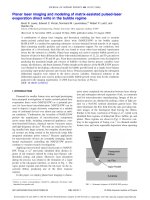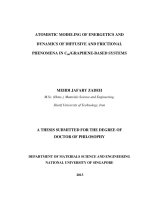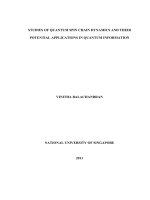Nonlinear dynamics and modeling of heart and brain signals
Bạn đang xem bản rút gọn của tài liệu. Xem và tải ngay bản đầy đủ của tài liệu tại đây (1.65 MB, 210 trang )
NONLINEAR DYNAMICS AND MODELING OF HEART
AND BRAIN SIGNALS
KANNATHAL NATARAJAN
NATIONAL UNIVERSITY OF SINGAPORE
2008
NONLINEAR DYNAMICS AND MODELING OF HEART
AND BRAIN SIGNALS
KANNATHAL NATARAJAN
(M.Sc., Nanyang Technological University)
A THESIS SUBMITTED
FOR THE DEGREE OF DOCTOR OF PHILOSOPHY
DEPARTMENT OF ELECTRICAL AND COMPUTER
ENGINEERING
NATIONAL UNIVERSITY OF SINGAPORE
2008
Acknowledgements
It is a great pleasure to thank and convey my gratitude to the people who have
helped me in this research work. First I would like to express my sincere thanks and
gratitude to my supervisor Dr. Sadasivan Puthusserypady for his ever-present guidance
and direction throughout this research work. He provided the counsel necessary for the
completion of the thesis, and his advice and interest contributed immeasurable to this
research work. Above all, he provided me constant encouragement and complete support
in my research activities. I take this opportunity to thank Dr. Vadakkepat Prahlad for
his timely help and support in completion and submission of the thesis.
I take this opportunity to thank Dr. Lim Choo Min, Dr. Rajendra Acharya and
other staffs of Biomedical Engineering centre of NgeeAnn polytechnic for their help,
support, interest and valuable suggestions for my research. I hereby express my sincere
thanks to all the faculty and staff of National University of Singapore who has supported
me to complete the research work. I also would like to thank all my family members and
friends for their constant support and encouragement during all these years.
Special thanks to everyone who have, in one way or another, helped me to
conduct this research.
i
Table of Contents
Acknowledgements 3
Table of Contents i
Summary vi
List of Abbreviations ix
List of Tables xii
List of Figures xv
Chapter 1 Introduction 1
1.1 Introduction 1
1.2 Motivation 3
1.3 Objectives 5
1.4 Contributions 6
1.5 Organization of the Thesis 7
Chapter 2 Literature Review 10
Chapter 3 Chaotic Analysis of HRV Signals 23
3.1 Description of the Data 24
3.2 Fractal Dimension Analysis 28
3.2.1 Higuchi’s Algorithm 28
ii
3.2.2 Katz Algorithm 29
3.2.3 Validation of the FD Algorithms 30
3.3 State-space Reconstruction 31
3.3.1 Estimation of Embedding Dimension 33
3.3.2 Estimation of Embedding Delay Time 35
3.4 Nonlinearity 41
3.4.1 Test for Nonlinearity 42
3.5 Stationarity 43
3.6 Chaotic Invariants Analysis 47
3.6.1 Correlation Dimension 48
3.6.2 Lyapunov Exponents 49
3.6.3 Hurst Exponent 51
3.6.4 Poincare Geometry 52
3.6.5 Detrended Fluctuation Analysis 55
3.7 Entropy Analysis 58
3.7.1 Spectral Entropy 59
3.7.2 Renyi’s Entropy 60
3.7.3 Kalmogorov Sinai Entropy 60
3.7.4 Approximate Entropy 61
iii
3.8 Feature Extraction Results and Discussion 62
3.9 Conclusion 72
Chapter 4 Nonlinear Dynamics of Brain Signals 73
4.1 Description of the Data 76
4.2 Test of Nonlinearity 80
4.3 Chaotic Invariants Analysis 81
4.4 Fractal Dimension Analysis 95
4.5 Conclusion 97
Chapter 5 Classifier Architectures for Cardiac Health and Mental Health
Diagnosis 99
5.1 Neural Network Classifier 100
5.1.1 Radial Basis Function 103
5.2 Fuzzy Classifier 105
5.3 Adaptive Neuro Fuzzy Classifier 107
5.4 Classification of HRV Signals 111
5.5 Classification of EEG Signals 116
5.6 Conclusion 119
Chapter 6 Linear Modeling of Heart and Brain Signals 121
6.1 Signal Modeling 121
iv
6.2 Modeling Techniques 124
6.3 Linear Models 124
6.3.1 Parametric Model 125
6.4 Modeling of HRV Signals 127
6.4.1 Validation of the Signal Model 133
6.5 Modeling of EEG Signals 136
6.5.1 Validation of the Signal Model 139
6.6 Conclusion 141
Chapter 7 Nonlinear Modeling of Heart and Brain Signals 142
7.1 Nonlinear Modeling 142
7.2 Modeling Techniques 143
7.2.1 Recurrent Neural Network (Elman Method) 143
7.2.2 Pipelined - Recurrent Neural Network (PRNN) 149
7.3 Implementation of the PRNN Network 156
7.4 Modeling of HRV Signals 157
7.4.1 Validation of the Signal Model 165
7.5 Modeling of EEG Signals 167
7.5.1 Validation of the Signal Model 170
7.6 Comparison of Linear and Nonlinear Modeling Techniques 172
v
7.7 Conclusion 173
Chapter 8 Conclusion 175
8.1 Conclusion 175
8.2 Recommendations for Future Work 178
References 180
vi
Summary
The theory of nonlinear dynamic systems provides new ways to handle complex
dynamic systems. Chaos theory offers new concepts, algorithms and methods for
processing, enhancing and analyzing the measured signals. In recent years, researchers
have been applying the concepts of chaos theory to bio-signal analysis. In this work, the
complex dynamics of the heart (Electrocardiogram (ECG)) and the brain
(Electroencephalogram (EEG)) signals are analyzed in detail using the tools of chaos
theory.
In the modern world, every year several thousands of people die of cardiac
problems. This makes the automatic analysis and the assessment of risk for these
problems a critical task. Analyses using the conventional linear methods are often found
to produce inconclusive results. Therefore in this work we propose and apply
unconventional methods of nonlinear dynamics to analyze ECG and EEG signals.
In the case of ECG, the heart rate variability (HRV) signal is analyzed using
various complexity measures that are basing on symbolic dynamics. These complexity
measures with the parameters in the frequency domain serve to be a promising way to get
a more precise definition of individual risk. This is done in two stages: (i) feature
extraction and (ii) classification. A feature library with more than ten features extracted
from the HRV signal is developed for eight different cardiac health states. The measures
vii
are then validated with neural network and fuzzy classifiers for their ability to do more
precise classification. A classification accuracy of about 80-95% is achieved in our work.
In EEG analysis, the search for the hidden information for identification of
seizures has a long history. In this work, an effort is made to analyze the normal and
epileptic EEGs using the chaos theory. In this work, emphasis is made on the extraction
and selection of key and relevant features that distinguish EEG (on the same subject) with
and without the epileptic seizures. The features extracted include chaotic invariants and
information theory features. Results obtained are promising and clear differences are seen
in the extracted features between normal and epileptic EEGs.
At present, new biomedical signal processing algorithms are usually evaluated by
applying them to signals acquired from real patients. Most cases, the signals are of short
duration for the evaluator to decide on the accuracy and reliability of the given algorithm.
To facilitate this evaluation, it is required to generate longer duration signals from these
short duration signals while preserving the characteristics of the signal. In this work, we
have proposed linear and nonlinear techniques to model the HRV and EEG signals from
their respective short duration data. From the models, longer duration signals are
synthesized for further analysis. Results of these generated signals show that the models
can generate the HRV and EEG signals that approximate the real HRV and EEG signals.
The HRV signal models are useful in the prediction of the heart rate signals and
subsequently help in the analysis and diagnosis of cardiac abnormalities. The modeling of
EEG signals can be a very useful tool in the prediction of seizures.
viii
In this work, we have also proposed a new nonlinear model architecture using
pipelined recurrent neural network (PRNN) to model the HRV and EEG signals. The new
architecture performs better in terms of prediction error (measured as normalized root
mean square error (NRMSE)) and signal to noise ratio (SNR). The signals modeled using
the proposed architecture is able to successfully model the inherent nonlinear
characteristics of the experimental signals. From the results it can be clearly seen that the
proposed architecture clearly outperforms the linear models. This is due to the nonlinear
model’s inherent ability to model the underlying nonlinearity of the system under
investigation.
ix
List of Abbreviations
AF
Atrial Fibrillation
AIC
Akaike Information Criteria
AMI
Average Mutual Information
ANFIS
Adaptive Neuro Fuzzy Inference System
ANN
Artificial Neural Network
ANOVA
Analysis of Variance
APEN
Approximate Entropy
AR
Auto-Regressive
AV
Atrio-Ventricular
BBB
Bundle Branch Block
BPM
Beats Per Minute
BPTT
Back Propagation Through Time
CA
Cardiac Arrest
CAD
Coronary Artery Disease
CHB
CJD
CTM
Complete Heart Block
Creutzfeldt–Jakob Disease
Central Tendency measure
x
CTSA
Chaotic Time-Series Analysis
DFA
Detrended Fluctuation Analysis
ECG
Electrocardiogram
EEG
Electroencephalogram
FD
Fractal Dimension
FNN
False Nearest Neighbor
FPE
Final Prediction Error
FT
Fourier Transformation
FFT
Fast Fourier Transform
HF
High Frequency
HRV
Heart Rate Variability
ISCH
Ischemic/Dilated Cardiomyopathy
IVCD
Intraventricular Conduction Defects
KSEN
Kolmogorov-Sinai Entropy
LBBB
Left Bundle Branch Block
LF
Low Frequency
MA
Moving Average
NN
Neural network
NRMSE
Normalized Root Mean Square Error
NSR
Normal Sinus Rhythm
NTSA
Nonlinear Time-Series Analysis
PRNN
Pipelined Recurrent Neural Network
xi
Probability density function
PSD
Power Spectral Density
PVC
Pre-Ventricular Contraction
RBF
Radial Basis Functions
REN
Renyi’s Entropy
RNN
Recurrent Neural Networks
RSA
Respiratory Sinus Arrhythmia
RTRL
Recurrent Time Recurrent Learning
SA
Sino-Atrial
SD
Standard Deviation
SNR
Signal to Noise Ratio
SEN
Spectral Entropy
SSS
Sick Sinus Syndrome
VF
Ventricular Fibrillation
VLF
Very Low Frequency
VT
Ventricular Tachycardia
WT
Wavelet Transform
xii
List of Tables
Table 3.1 ECG Data for eight cardiac health states 25
Table 3.2 Surrogate Data analysis for eight cardiac health states 43
Table 3.3 Results of HRV analysis. 64
Table 4.1 Results of surrogate data analysis 80
Table 4.2 Chaotic measures of control, background and epileptic groups 89
Table 4.3 Results of Higuchi’s and Katz FD algorithms 96
Table 5.1 Results of ANN classifier 115
Table 5.2 Results of fuzzy classifier 115
Table 5.3 Results of ANFIS classifier 115
Table 5.4 Results of a simple classifier implemented with one input feature 116
Table 5.5 Results of ANN classifier for EEG signal classification 118
Table 5.6 Results of FUZZY classifier for EEG signal classification 118
Table 5.7 Results of ANFIS classifier for EEG signal classification 118
Table 5.8 Results of simple classifier implemented with one/ two input features 118
xiii
Table 6.1 SNR and NRMSE (%) values of the predicted signals using Burg’s method.
133
Table 6.2 Comparison of LF/HF Ratio of the predicted signals with the original signal.
135
Table 6.3 Chaotic measures of HRV signal - Actual. 135
Table 6.4 Chaotic measures of modeled HRV signal – Burg’s method. 136
Table 6.5 SNR and NRMSE (%) values of the predicted signals from the model. 138
Table 6.6 Chaotic measures of the modeled normal EEG signal 139
Table 6.7 Chaotic measures of the modeled background EEG signal 140
Table 6.8 Chaotic measures of the modeled epileptic EEG signal 140
Table 7.1 NRMSE (%) values of the predicted HRV signals from the Elman and
PRNN model 163
Table 7.2 SNR values of the predicted HRV signals from the Elman and PRNN model.
163
Table 7.3 Comparison of LF/HF ratio of the predicted signals with the original signal.
164
Table 7.4 Chaotic measures of the modeled HRV signal - Elman method 165
Table 7.5 Chaotic measures of the modeled HRV signal - PRNN method 166
Table 7.6 NRMSE (%) values of the predicted EEG signals from the Elman and PRNN
model 170
xiv
Table 7.7 SNR values of the predicted EEG signals from the Elman and PRNN model.
170
Table 7.8 Chaotic measures of the modeled EEG signals - Elman method 171
Table 7.9 Chaotic measures of the modeled EEG signals - PRNN method 171
xv
List of Figures
Figure 3.1 FD computed using Higuchi and Katz method versus theoretical FD 31
Figure 3.2 Variation of correlation dimension for different embedding dimension 34
Figure 3.3 AMI of normal HRV signal 36
Figure 3.4 Phase-space plot of eight classes of HRV signals 41
Figure 3.5 Illustration of Recurrence plots 45
Figure 3.6 Recurrence plot of the HRV signals of eight cardiac states 47
Figure 3.7 Poincare plot for the 8 classes of HRV signals 55
Figure 3.8
)(nF plotted against several box sizes,
n
, on a log-log scale 58
Figure 3.9 Variation of the chaotic measures of the HRV signals. 66
Figure 3.10 Results of multiple comparison test of the chaotic measures of the HRV
signals. 68
Figure 4.1 (a) Normal EEG signal (b) Epileptic EEG signal (c) Background EEG
signal 78
Figure 4.2 Sliding observation window (Normal EEG signal) 79
Figure 4.3 Sliding observation window (Epileptic EEG signal) 79
Figure 4.4 Variation of correlation dimension for different embedding dimension 81
Figure 4.5 AMI of normal EEG signal 82
xvi
Figure 4.6 AMI of epileptic EEG signal 83
Figure 4.7 AMI of background EEG signal 83
Figure 4.8 Phase-space plot of normal EEG signal 84
Figure 4.9 Phase-space plot of epileptic EEG signal 85
Figure 4.10 Phase-space plot of background EEG signal 85
Figure 4.11 Recurrence plot of normal EEG signal. 86
Figure 4.12 Recurrence plot of epileptic EEG signal 87
Figure 4.13 Recurrence plot of background EEG signal 87
Figure 4.14 Inter subject variation of
2
D
for normal EEG signal 89
Figure 4.15 Inter subject variation of
2
D
for epileptic EEG signal 90
Figure 4.16 Inter subject variation of
2
D
for background EEG signal 90
Figure 4.17 Variation of Chaotic measures for the EEG signal 91
Figure 4.18 Results of Multiple comparison test of EEG chaotic measures 92
Figure 4.19 FD of EEG signals using Higuichi’s algorithm 96
Figure 4.20 FD of EEG signals using Katz algorithm 97
Figure 5.1 A typical neuron 101
Figure 5.2 Neuron model 102
Figure 5.3 RBF network architecture 105
xvii
Figure 5.4 A fuzzy classification system 106
Figure 5.5 ANFIS architecture 110
Figure 5.6 Initial membership function for input 1(
1
λ
) 113
Figure 5.7 Final membership function for input 1(
1
λ
) 113
Figure 5.8 Final decision surface for input 1(
1
λ
) and input 2 (SEN) 114
Figure 5.9 Final decision surface for input 1(
1
λ
) and input 3 (SD1/SD2) 114
Figure 5.10 Final decision surface for input 3(SD1/SD2) and input 2 (SEN) 114
Figure 5.11 ANFIS architecture for classification of EEG signals 117
Figure 6.1 Original, reconstructed and error signals for various HRV signals using
the AR modeling technique. 132
Figure 6.2 Actual and reconstructed EEG signals using Burg’s method 138
Figure 7.1 Elman network architecture 146
Figure 7.2 Block diagram of the PRNN model 150
Figure 7.3 PRNN Network architecture (a) Nonlinear subsection (b) Linear
subsection 152
Figure 7.4 Generalized PRNN architecture of i
th
module 153
Figure 7.5 Original, reconstructed and error signals for various HRV signals using
the Elman network. 158
Figure 7.6 Original, reconstructed and error signals for various HRV signals using
the PRNN network 162
xviii
Figure 7.7 Original, reconstructed and error signals for EEG signals using the Elman
network. 168
Figure 7.8 Original, reconstructed and error signals for EEG signals using the PRNN
network. 169
Chapter 1: Introduction
1
Chapter 1 Introduction
1.1 Introduction
Computer technology has an important role in structuring biological systems. The
explosive growth of high performance computing techniques in recent years with regard
to the development of good and accurate models of biological systems has contributed
significantly to new approaches to fundamental problems of modeling transient behavior
of biological systems.
The importance of biological time series analysis, which exhibits typically
complex dynamics, has long been recognized in the area of non-linear analysis. Several
approaches have been proposed to detect the (hidden) important dynamical properties of
the physiological phenomenon. The nonlinear dynamical techniques are based on the
theory of chaos and have been applied to many areas including the areas of medicine and
biology [1].
A great deal of attention has been focused on the extraction of dynamical
information from chaotic time series [1-3]. Chaos is the state in which a nonlinear
dynamical system exhibits bounded motion, with exponential sensitivity to initial
conditions. The initially neighboring state of a chaotic system diverges exponentially as
Chapter 1: Introduction
2
the system evolves forward in time [4]. Chaotic time series analysis has greatly enhanced
the understanding of chaos in experimental systems by allowing multidimensional
dynamical information to be recovered from a time series of measurements of a single
variable [1-3]. This is achieved using the method of time delay embedding, which allows
the recovery of information from all degrees of freedom which are coupled to the
observable [1]. This allows the strange attractor
1
of a chaotic dynamical system to be
extracted from a time series of measurements of a single variable. The simplicity of the
technique and the accessibility of experimental time series have encouraged the rapid
exploration of numerous fields as varied as plasma fluctuations [2], climatic variations
[5], non-equilibrium chemical systems [6], etc.
In this work, methods of chaotic time series analysis are applied to bio-signals
such as the heart rate variability (HRV) signal and the electroencephalogram (EEG)
signal. The HRV is extracted from the electrocardiogram (ECG) signal. The ECG is the
electrical signal generated by the heart’s muscles measured on the skin surface of the
body. On the other hand, the EEG represents the time series that maps the voltage
corresponding to neurological activity of the brain as a function of time. These two
signals are essentially non-stationary in nature; they display a fractal
2
like structure. They
may contain indicators of current disease, or even warnings about impending diseases.
The indicators may be present at all times or may occur at random in the time scale.
1
An aattractor is a set of states to which a dynamical system evolves after long enough time. An attractor is
described as strange attractor if it has non-integer dimension and dynamics on it are chaotic.
2
Fractal is a fragmented geometric shape that exhibits self similarity by having same type of structures on
all scales.
Chapter 1: Introduction
3
However, to (study and) pinpoint anomalies in voluminous data collected over several
hours is strenuous and time consuming. Therefore, computer based analytical tools for in-
depth study and classification of data over day long intervals can be very useful in
diagnostics.
1.2 Motivation
ECG has a basic role in cardiology since it consists of effective simple
noninvasive low cost procedures for the diagnosis of cardiac disorders that have high
epidemiological incidence and are very relevant for their impact on patient life and social
costs. Pathological alterations observable by ECG are cardiac rhythm disturbances (or
arrhythmia), dysfunction of myocardial blood perfusion (or cardiac ischemia), chronic
alteration of the mechanical structure of the heart. Arrhythmias are considered to lead to
life threatening conditions and the patients with arrhythmias are subjected to continuous
monitoring in the intensive care units. Thus the automated and reliable detection of
abnormalities in intensive care patients is very essential and critical. Recently lot of
research is being carried out for automating the detection of abnormalities by applying
various engineering methods and unconventional techniques to help the doctor to
diagnose and act faster in case of emergency conditions. And also designing low cost
high performance simple to use and portable equipment for ECG offering a combination
of diagnostic features seem to be globally worthwhile. Such equipment should embed
and integrate several techniques of data analysis such as signal processing, pattern
Chapter 1: Introduction
4
detection and recognition, decision support and human computer interaction. Thus
computerized methods are to be applied for detection and classification of abnormalities.
Epilepsy is a pathological condition characterized by spiky patterns in continuous
EEG and seizure at times [7]. Approximately one percent of the world’s population has
epilepsy, one third of whom have seizures not controlled by medications [7, 8].
Individuals with epilepsy suffer considerable disability from seizures and resulting
injuries, the stigma and social isolation attached to having seizures, and from side effects
of medical and other therapies. In some patients, whose seizures reliably begin in one
discrete region, usually in the mesial (middle) temporal lobe, may be cured by surgery.
This requires removing large volumes of brain tissues, due to the lack of a reliable
method for accurately locating the region of seizure onset and the pathways through
which seizures spread. Successful surgical treatment of focal epilepsies requires exact
localization of the epileptic focus and its delineation from functionally relevant areas. For
this purpose, different pre-surgical evaluation methodologies are currently in use [9].
Neurological and neuropsychological examinations are complemented by neuro-imaging
techniques that try to identify potential morphological correlates. Currently, for
localization of the epileptic focus, the patient’s spontaneous habitual seizure is recorded
using electroencephalography. Depending on the individual occurrence of seizures this
task requires long lasting and continuous recordings of EEG. In case of ambiguous scalp
EEG findings, invasive recordings of electrocorticogram and stereo-EEG via implanted
depth electrodes are used. This procedure is time consuming and offers greater risk to the









